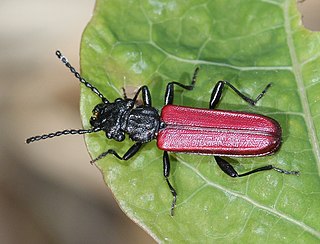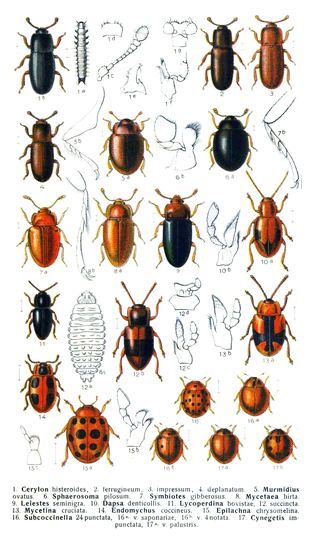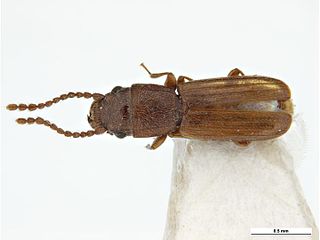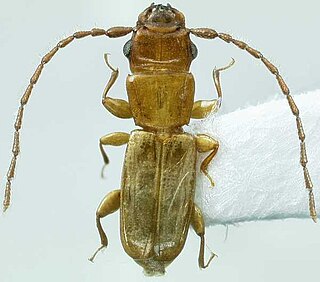
The Cucujidae, or flat bark beetles, are a family of distinctively flat beetles found worldwide under the bark of dead trees. The family has received considerable taxonomic attention in recent years and now consists of 70 species distributed in five genera. It was indicated Cucujus species are scavengers, only feeding on pupae and larvae of other insects and on other subcortical beetles such as their own. Since the Cucujidae prey on larvae of potentially tree damaging beetles that spread fungal diseases, they are considered to be beneficial to the health of living trees.

Cucujoidea is a superfamily of beetles. This group formerly included all of the families now included in the superfamily Coccinelloidea. They include some fungus beetles and a diversity of lineages of "bark beetles" unrelated to the "true" bark beetles (Scolytinae), which are weevils.

Cryptolestes is a genus of beetles in the family Laemophloeidae. Several species are known as economically important pests of stored products, especially food grains. The four most notorious species are Cryptolestes ferrugineus, Cryptolestes pusilloides, Cryptolestes pusillus, and Cryptolestes turcicus. C. capensis, C. klapperichi, and C. ugandae are less widespread pests. Species in this genus can be hard to distinguish from one another, and definitive identification often requires close examination of the genitalia.

Erotylidae, or the pleasing fungus beetles, is a family of beetles belonging to Cucujoidea containing over 100 genera. In the present circumscription, it contains 6 tribes and 10 subfamilies. In other words, the narrowly circumscribed Erotylidae correspond to the subfamily Erotylinae in the definition sensu lato. There are doubts on the monophyly of lower ranked taxa within Erotylidae, with further phylogenetic studies requiring better sampling and studies of unexplored character sets, for example the metendosternite and penile flagellum, which are generally lacking detailed morphological studies within the Coleoptera literature. The Eroytlina taxonomy is based on traits such as their different colors and not off morphological differences like mouthparts, thorax, and abdominal terminalia (Pecci-Maddalena).

Cucujus cinnaberinus is a species of beetles in the family Cucujidae, the flat bark beetles. It is native to Europe, being most common in Central Europe and rare in much of Southern and Western Europe.

Melyridae are a family of beetles of the superfamily Cleroidea.

Jacobsoniidae are a family of tiny beetles belonging to Staphylinoidea. The larvae and adults live under bark, in plant litter, fungi, bat guano and rotten wood. There are around 28 described species in three genera:

Laemophloeidae, "lined flat bark beetles," is a family in the superfamily Cucujoidea characterized by predominantly dorso-ventrally compressed bodies, head and pronotal discs bordered by ridges or grooves, and inverted male genitalia. Size range of adults is 1–5 mm (0.04–0.2 in) in length. Currently, it contains 40 genera and about 450 species, and is represented on all continents except Antarctica; species richness is greatest in the tropics.

Silvanidae, "silvan flat bark beetles", is a family of beetles in the superfamily Cucujoidea, consisting of 68 described genera and about 500 described species. The family is represented on all continents except Antarctica, and is most diverse at both the generic and species levels in the Old World tropics.

Laemophloeus is a genus of beetles; it is the type genus of the family Laemophloeidae. The genus has been almost completely reviewed in modern times.

Lathropus is a genus of beetles in the family Laemophloeidae. It has been the subject of recent taxonomic study. Lathropus species are minute (<2mm) flattened beetles with short, clubbed antennae, closed mesocoxal cavities, extremely dense surface sculpture, and dorsal pubescence composed of bifurcate setae. Currently recognized valid species are:

Placonotus is a genus of beetles in the family Laemophloeidae. There are 40 currently recognized species, known from all continents except Antarctica. Placonotus species are small (~2mm), elongate, flattened beetles, characterized by long filiform antennae, presence of a frontoclypeal suture, open anterior coxal cavities, and broadly rounded intercoxal process of abdominal ventrite III. Males have the 8th abdominal segment modified to form claspers used during mating. Adults and larvae are found under dead bark, where they feed on fungi. Currently recognized species are:

Passandridae, the "parasitic flat bark beetles," are a family of beetles notable for being one of the very few beetle families with larvae that are, as far as known, exclusively ectoparasitic on the immature stages of other beetles and Hymenoptera.

Epomis is a subgenus of ground beetle genus Chlaenius. The larvae of this subgenus are notable for being obligate role-reversal predators. Amphibians such as frogs are normally predators of beetles; however, Epomis larvae feed exclusively on amphibians.

Palaestes is a genus of beetles in the family Cucujidae. It contains eight currently recognized species. Like all members of the Cucujidae, adults are greatly dorso-ventrally compressed. All known species of Palaestes are brightly colored red or yellow and black, and the males have curiously modified mandibles that look like ice tongs; female mandibles are not modified. Palaestes shares with the Australian-New Zealand genus Platisus the character of the male genitalia, which lacks a flagellum, lying on its side in the abdomen, versus inverted in Cucujus and Pediacus.

Pediacus is the largest genus in the family Cucujidae of flat bark beetles. It contains 31 currently recognized species. Pediacus adults are relatively small (2.7-7.0mm), flattened brownish beetles with no or very small temples, and short antennae with a distinct club. Male genitalia are inverted and possess a short flagellum.

Cucujus clavipes is known as the flat bark beetle. It is found throughout North America. These are generally found near tree line under bark of dead poplar and ash trees. C. clavipes are described as phloem-feeding and often predators of other small insects, such as wood-boring beetles, and mites. These are usually seen during spring-summer seasons. Having a cold habitat, these beetles must go through several physiological mechanisms to survive; they are recognised for their ability to change their overwintering mechanisms.

Pycnomerus is a genus of ironclad beetles in the family Zopheridae. There are more than 20 described species in Pycnomerus.
Hapalips is a genus of pleasing fungus beetles in the family Erotylidae. There are about 12 described species in Hapalips.

Myrabolia is the only genus in the beetle family Myraboliidae in the superfamily Cucujoidea. It has about 13 species, found in Australia. Adults and possibly larvae live under the bark of Eucalyptus trees.


















